Messerschmitt Bf 110 G-4
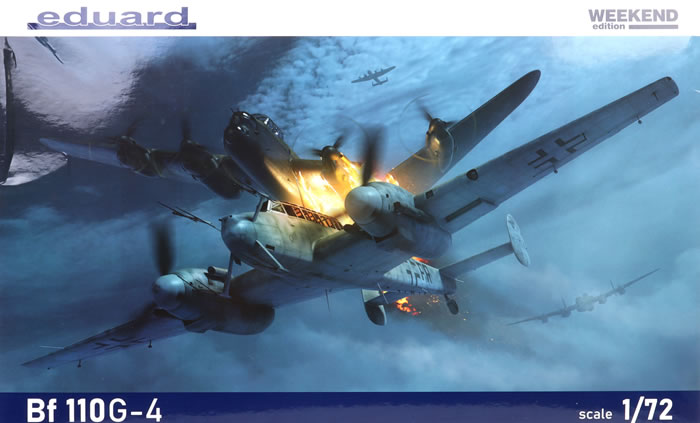
Weekend Edition, 1/72 scale
| S u m m a r y : |
Catalogue Number: |
Eduard Kit No. 7465 - Messerschmitt Bf 110 G-4 Weekend Edition
|
Scale |
1/72 |
Contents and Media |
211 parts in grey coloured plastic; 13 parts in clear; brass photo-etched fret; markings for four aircraft; instructions.
|
Price |
USD$39.95 plus shipping available online from Eduard
GBP£14.50 EU Price (£17.67 Export Price) plus shipping available online from Hannants
and specialist hobby retailers worldwide |
Review Type |
First Look |
Advantages |
Beautiful mould quality and detailing, great decals, especially the additional stencil sheet, and clear instructions, a nice set of parts for the spares box and the finer aerial parts available on the PE fret for good measure.
|
Disadvantages |
None noted. |
Conclusion |
Another lovely kit from Eduard and the definitive Bf 110 kit in this scale with great surface and interior detail with a good choice of schemes for this dedicated night fighter variant. |
Reviewed by Graham Carter

This significant aeroplane hardly needs an introduction but suffice to say that it was produced in a bewildering number of variants that have kept historians, technophiles and modellers in deep discussion for decades.
In the ‘One True Scale’ there have been an understandably large number of kits from the likes of Monogram, Matchbox, Airfix, HobbyBoss and this series from Eduard. The Eduard kits have proved to be the most accurate and detailed of all the kits since their release about ten years ago, although they do have some minor issues that reflect the problems of sorting out details from one variant from another, and the fact that many variations were field jobs. As always, check your references before committing to building, or just go with the flow. The radar equipped variant of the Bf 110 has been released by both FROG in 1977 and Revell in 1984 and by High Planes in about 2012 but the series of kits by Eduard relegates these older ones to the collector’s market.

This kit is not the first Eduard edition of the 110 G-4 as it first appeared in 2013 as a variant of the 2012 G-2 kit number 7085 and in 2018 with new decals. The kit comes in the larger box used by Eduard these days, but the plastic contents are identical to the early releases, with different decal choices and instructions for the painting. The instruction book is A4 and contain painting instructions in colour. The strong large box comes with a rather dramatic illustration one of the decal choices, Wilhelm Johnen’s mount from 7/NJG 6 shooting down a Lancaster from underneath with its Schrage Music weapons.
The parts are in the familiar mid-grey slightly shiny plastic and are beautifully moulded with no sign of flash or seams, and come in protective clear resealable sleeves, with the clear parts and decals in separate sleeves for protection. The moulded surface detail is subtle and looks great, as do the myriad of tiny parts that make up the interior and undercarriage. Sprue gates are narrow and in unobtrusive places but some care will be needed to be taken with some of the finer parts. Being a composite 110D/E/G set, there are a number (49) of parts not used in this version including upper noses, rocket pods, a number of underwing and fuselage fuel tanks (including the huge Dackelbauch) and smaller wheels. Unlike the E variant kit, there is only a single fuselage provided with the short tail, and a small sprue contains the main radar array sections.
The kit provides parts specifically for the G variant such as the upper nose with a bulged front, larger wheels ( although the hub detail is a bit shallow compared to photos I have looked at - resin replacements may be more suitable), appropriate armoured canopy front, and a new sprue containing a mass of aerial parts for the radar arrays (two different ones are catered for).

As a night fighter the model comes with both the normal and the Schrage Music machine gun set-up in the cockpit rear and the rather complex flame damper exhausts in two versions depending on the decal choice
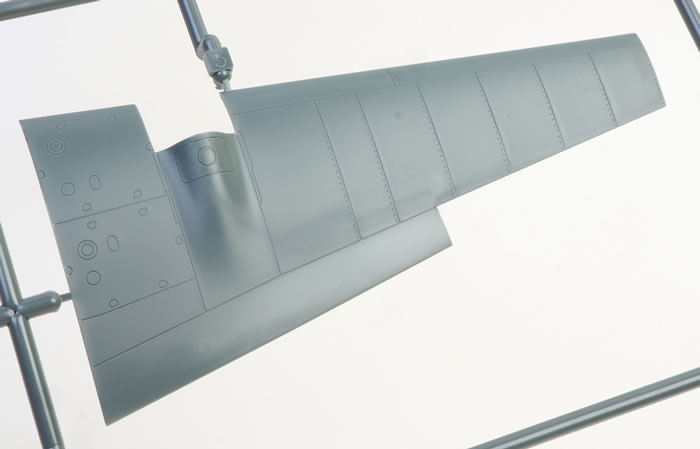
Being a Weekend Edition, there are no masks but there are so many finely moulded parts and decals that these are not really missed. A photo-ethed fret, however, does provide a very fine set of radar arrays from the two variations and these will be much finer than plastic ones.
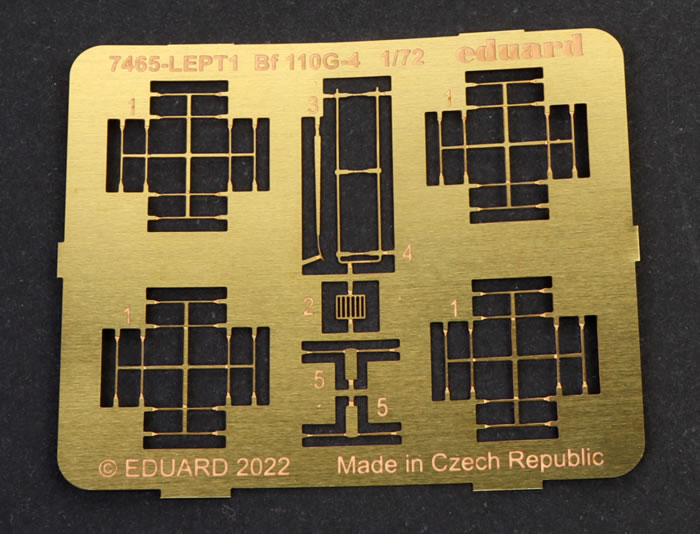
The main supports for the arrays are in plastic.
Markings
The decals, unusually for a Weekend Edition, offer four choices.
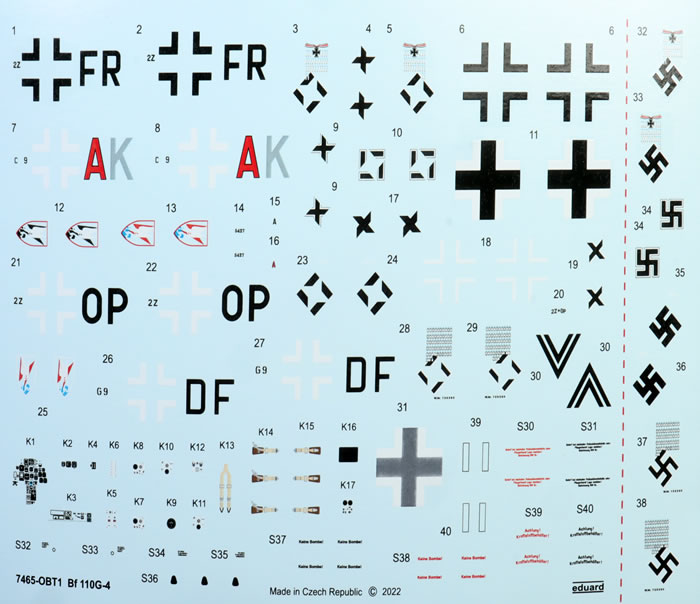
They are :-
-
2Z+FR of Hptm. Wilhelm Johnen of 7./NJG 6, from Neubiberg, Germany 1945 in RLM76 undersides and RLM75 upper surfaces covered with RLM76 sprayed squiggles and FuG 220 antennae,
-
WNr 5427, C9+AK , of Oblt Ernst-Georg Drunkler of 2/NJG 5, at Leeuwarden, Netherlands , June 1943 in RLM76 lower surfaces that wrap on top of the wing leading edges with the upper surfaces in RLM 74/ RLM 75 and the FuG202 antennae,
-
WNr 5547, 2Z+OP, of Ofw. Helmut Treynogga and UFFz. Heinz Scwarz,in a similar scheme to ‘3’ above except that the upper colours come right down the fuselage sides and the nose area is RLM76 with blotches of RLM75 with black underside to the starboard wing, and the FuG202 antennae, and
-
WNr. 720260, of Oblt Heinz-Wolfgang Schnaufer from Stab IV/NJG 1, Saint Trond in Belgium, April 1944, in overall RLM 76 with heavy mottling of RLM 74/75, the result of the overspray of RLM 76, with black underside to the starboard wing, and the FuG220 antennae
All-in-all a very interesting variety of colours and ones that will appeal to many Luftwaffe modellers.
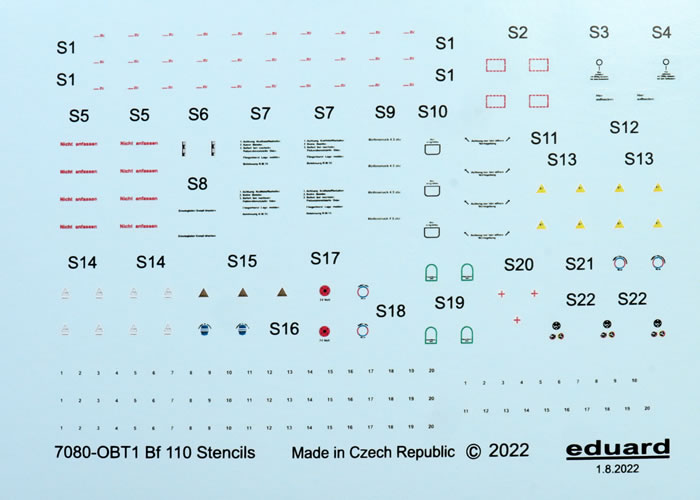
Decals are beautifully printed with great density and register and minimal carrier film. Swastikas come in both cut and full variants - the latter being snipped off for sale in countries where the symbol is forbidden.
A lovely kit as you would expect from this prolific Czech company and one that will be welcomed by all Luftwaffe modellers. It makes a welcome return and if you missed the earlier releases then it comes highly recommended.
Thanks to Eduard for the sample

Review Text & Images Copyright © 2022 by Graham Carter
Images Copyright © 2022 by Brett Green
Page Created 13 December, 2022
Last updated
13 December, 2022
Back to HyperScale Main Page
Back to Reviews Page |
